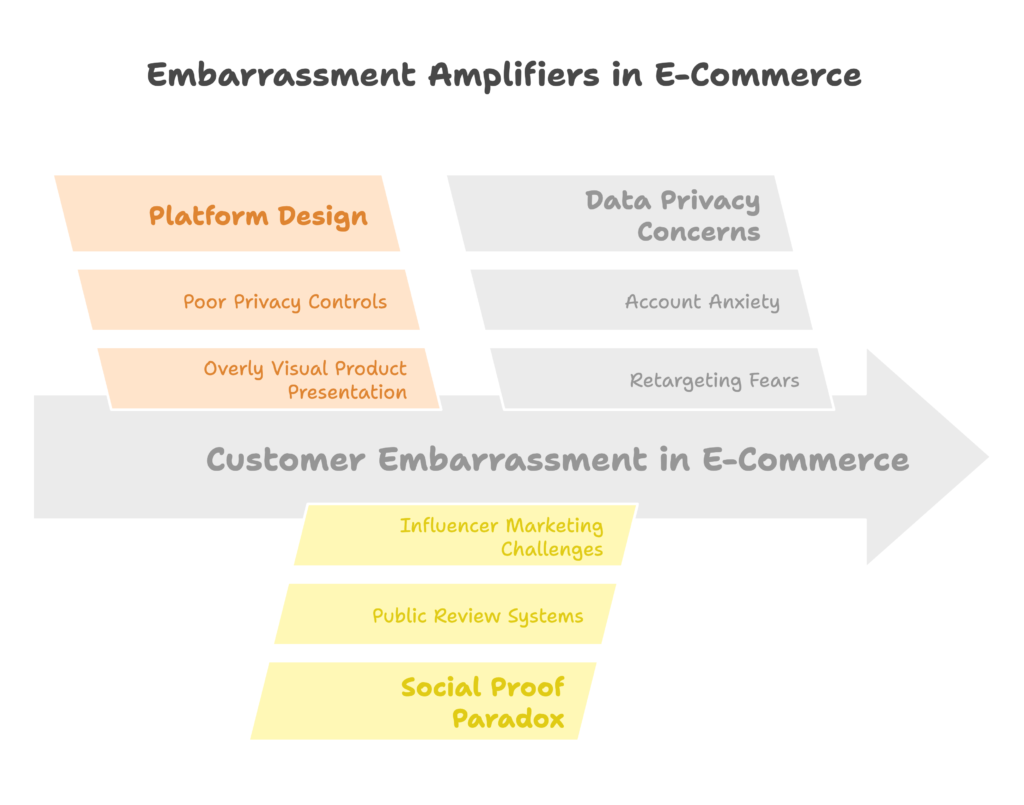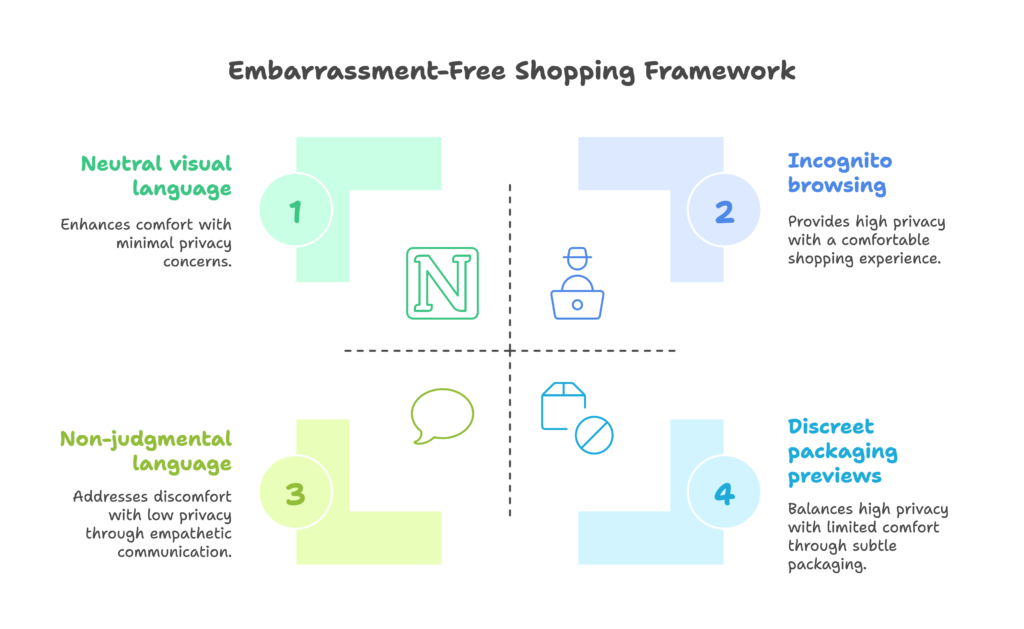Have you ever felt your cheeks burn red while buying certain products? Perhaps you’ve abandoned an online cart full of items because you were worried about what the delivery person might think? Or maybe you’ve added random items to your shopping basket just to hide that one thing you actually came to buy?
If any of this sounds familiar, you’re not alone. Shopping embarrassment affects millions of people every day and costs businesses billions in lost sales. The good news? It doesn’t have to be this way.
In this article, you’ll discover:
- Why we feel embarrassed when buying certain products
- How online stores often accidentally make this worse
- Practical design solutions to create shame-free shopping experiences
- Real examples of businesses that transformed their sales by addressing customer embarrassment
- Step-by-step strategies you can implement today
Ready to turn uncomfortable shopping moments into satisfying customer experiences? Let’s dive in!
The Psychology of Embarrassment in Consumer Behavior
Before we can solve shopping embarrassment, we need to understand what’s happening in our brains when we feel it. Shopping embarrassment isn’t just an uncomfortable feeling—it’s a complex emotional response with real impacts on buying behavior.
Defining Embarrassment in Purchasing Contexts
When someone feels embarrassed while shopping, their brain’s amygdala—the part responsible for emotional responses—becomes highly active. This triggers a fight-or-flight response similar to what our ancestors felt when faced with physical danger. The difference? The “threat” here is social judgment.
Shopping embarrassment comes in two main forms:
- Public embarrassment: When others witness our purchase (like a cashier or fellow shoppers)
- Private embarrassment: When we feel uncomfortable even with no one watching (common in online shopping)
At its core, purchase embarrassment happens when buying a product conflicts with how we see ourselves or how we want others to see us. It’s that uncomfortable gap between your self-image and what your shopping cart says about you.
Embarrassment Triggers for Sensitive Products
Certain product categories are more likely to trigger embarrassment than others:
- Health and wellness products: Items related to sexual health, incontinence, or mental health medications often cause discomfort
- Socially stigmatized purchases: Products for weight loss, addiction recovery, or other conditions that carry social judgment
- Personal care taboos: Items addressing intimate hygiene needs or age-related concerns can feel exposing to buy
Understanding these triggers helps us identify where customers might need extra support in their shopping journey.
Behavioral Consequences of Purchase Embarrassment
When customers feel embarrassed, they change their shopping behavior in predictable ways:
- Cart abandonment: Many shoppers will leave a site entirely rather than complete a purchase that makes them uncomfortable
- Compensatory behaviors: Adding “decoy” items to hide the sensitive product or buying in unusually large quantities to reduce future embarrassment
- Brand avoidance: Even if the product works well, customers may avoid returning to a store where they felt embarrassed
The impact on business is clear: embarrassment doesn’t just create a bad customer experience—it directly reduces sales and prevents repeat business. But what makes this feeling worse in online environments? Let’s explore that next.
Embarrassment Amplifiers in E-Commerce Environments
You might think online shopping would eliminate embarrassment entirely—after all, there’s no cashier to make eye contact with. However, digital spaces often create their own unique forms of discomfort. Let’s examine how e-commerce can accidentally amplify customer embarrassment.

Platform Design Factors Increasing Discomfort
Many common website features can unintentionally make customers feel exposed:
- Overly visual product presentation: Large, detailed images of sensitive products can make browsers feel self-conscious, especially on shared devices
- Transparent checkout processes: When product names appear multiple times or in large text during checkout, it increases visibility and discomfort
- Poor privacy controls: Recommendation engines that suggest sensitive products while browsing other items (“Others who bought incontinence pads also bought…”) create unexpected moments of exposure
These design choices often prioritize visibility and upselling without considering the emotional impact on customers shopping for sensitive items.
Social Proof Paradox
While social proof (showing that others have purchased and enjoyed a product) typically boosts sales, it can backfire with sensitive products:
- Public review systems: Many customers won’t leave reviews for embarrassing products, creating artificially low review counts
- Social media integration: “Share your purchase” buttons or easy social media sharing can create anxiety about accidental exposure
- Influencer marketing challenges: Traditional approaches to influencer marketing often don’t work well for taboo categories, as few people want to become the public face of sensitive products
This creates a paradox where the very tools that build trust for most products can undermine it for sensitive ones.
Data Privacy Concerns
In today’s data-driven world, customers worry about who might see their purchase history:
- Account anxiety: Concerns that purchase history will be visible on return visits or to other users of shared accounts
- Retargeting fears: Worry that ads for sensitive products will follow them around the internet or appear on shared devices
- Data sharing vulnerabilities: Concerns about third-party apps or services gaining access to sensitive purchase information
These concerns create a unique challenge: how do we build personalized, convenient shopping experiences without sacrificing the privacy that sensitive product customers need? The answer lies in thoughtful design architecture, which we’ll explore next.
Architectural Framework for Embarrassment-Free Shopping
Now that we understand the problem, let’s look at solutions. Creating embarrassment-free shopping experiences isn’t about reinventing e-commerce—it’s about thoughtful adjustments to existing systems.

Here’s a framework for building shopping environments where customers feel safe and comfortable.
Interface Design Principles
Small visual changes can make a big difference in how comfortable customers feel:
- Neutral visual language: Using restrained, medical-style imagery and color schemes that don’t draw unnecessary attention
- Discreet packaging previews: Showing customers exactly how their order will arrive and offering plain packaging options
- Context-aware adaptations: Changing the interface based on product category—more subdued and private for sensitive items, more vibrant for non-sensitive ones
These principles help customers feel that their privacy is being respected from the moment they land on your page.
Anonymous Experience Pathways
Creating options for different levels of privacy allows customers to choose their comfort level:
- Optimized guest checkout: Making the no-account checkout process just as smooth and convenient as logged-in purchasing
- Incognito browsing: Offering session-based shopping that leaves no trace in browser history or on the account
- Account aliasing: Allowing customers to create separate profiles or shopping lists for different types of purchases
When customers know they can shop privately, they’re more likely to complete their purchase rather than abandoning their cart.
Communication Safeguards
How we talk about sensitive products dramatically affects customer comfort:
- Non-judgmental language: Using matter-of-fact, solution-focused copywriting that normalizes common health needs
- Medical-grade terminology: Offering both everyday terms and proper medical language to match different customer comfort levels
- Crisis response protocols: Training customer service teams to handle questions about sensitive products with empathy and without causing additional embarrassment
These communication approaches help customers feel understood rather than judged. But beyond these foundational elements, what technological solutions can take embarrassment-free shopping to the next level? Let’s find out.
Technological Solutions for Discreet Commerce
Technology isn’t just creating privacy challenges—it’s also offering powerful new solutions. Let’s explore the cutting-edge tools that are making discreet shopping easier than ever before.
AI-Powered Personalization
Artificial intelligence can create more sensitive, adaptive shopping experiences:
- Embarrassment prediction: Algorithms that identify potentially sensitive product categories and automatically adjust the shopping experience
- Dynamic UI adaptation: Interfaces that change based on browsing patterns, time of day, or device being used
- Conversational interfaces: Chat-based shopping assistants that can discretely guide customers through sensitive purchases in natural language
These AI tools create personalized experiences that protect privacy without requiring customers to explicitly request it.
Privacy-First Architecture
New privacy technologies are creating more secure ways to shop:
- Zero-knowledge payment systems: Methods that process transactions without storing identifying details
- Ephemeral data storage: Systems that automatically delete sensitive browsing data after completion or a set time period
- Blockchain privacy solutions: Decentralized technologies that can verify purchases without revealing customer identity
These approaches build privacy into the foundation of the shopping experience rather than adding it as an afterthought.
Sensory Safety Engineering
Beyond visual design, other sensory elements can enhance privacy and comfort:
- Adaptive controls: Options to quickly minimize screens or mute audio for sensitive product videos
- Virtual reality innovations: Developing neutral sensory experiences for VR shopping environments
- Customizable feedback: Letting customers choose how they interact with product information through different sensory channels
These sensory considerations create more inclusive experiences for all shoppers. Now, let’s look at how to put these ideas into practice, especially if you’re running a Shopify store.
Implementation Strategies for Shopify Merchants
Theory is helpful, but practical steps are essential. If you’re running a Shopify store that sells sensitive products, here’s your roadmap to creating a more comfortable shopping experience for your customers.
Platform Configuration Checklist
Start with these technical adjustments to your store:
- Enhanced privacy settings: Go beyond basic GDPR compliance with extra privacy controls for sensitive product categories
- App evaluation: Review all third-party apps for how they handle sensitive data and remove those that don’t meet high privacy standards
- Theme modifications: Adjust your store theme to allow for more neutral presentation of sensitive items, including subdued colors and discreet imagery
These technical foundations provide the infrastructure for everything else you’ll implement.
Staff Training Protocols
Your team needs special skills to handle sensitive product sales:
- Empathy-based service: Train customer service representatives to recognize and respond appropriately to signs of customer embarrassment
- Crisis communication: Develop specific scripts and procedures for handling sensitive customer questions or concerns
- Privacy-centered development: Ensure your development team understands the importance of building privacy into every new feature
These human elements are just as important as technical solutions in creating comfortable shopping experiences.
Continuous Improvement Systems
Measure and refine your approach over time:
- Discomfort metrics: Develop ways to track signs of customer embarrassment, such as high bounce rates on sensitive product pages
- Ethical testing: Set parameters for A/B testing sensitive features that respect customer privacy while gathering useful data
- Post-purchase follow-up: Create safe ways for customers to provide feedback about their shopping experience
With these measurement systems in place, you can continuously improve your approach. But what does success look like in practice? Let’s explore some real-world examples.
Case Studies in Embarrassment-Sensitive Commerce
Nothing demonstrates the power of embarrassment-free design like seeing it in action. Here are three real-world examples of businesses that transformed their results by addressing customer embarrassment head-on.
Sexual Wellness Success Story
A leading sexual wellness brand implemented a complete UX overhaul focused on reducing customer embarrassment:
- They redesigned their product pages with more subdued imagery and matter-of-fact, educational descriptions
- They created an anonymous community feature where customers could ask questions without revealing their identities
- They developed plain packaging with discreet shipping labels and provided clear previews of how packages would arrive
The results? Conversions increased by an impressive 142%, and shopping cart abandonment rates dropped significantly. Most importantly, return customers increased as people felt comfortable coming back to the store repeatedly.
Incontinence Product Breakthrough
A company selling incontinence products made several key changes to their shopping experience:
- They introduced multiple packaging options, including a “plain box” choice with no visible branding
- They developed a voice-assisted shopping feature, making it easier for elderly customers to shop without visual exposure
- They created a “quick reorder” function that minimized the time spent browsing potentially embarrassing products
These changes led to a substantial increase in repeat purchases, as customers felt more comfortable returning to a store that respected their privacy needs.
Mental Health Marketplace
An online marketplace for mental health products implemented several innovative features:
- They developed an AI-guided product discovery tool that helped customers find appropriate products through private, conversational interactions
- They worked with therapists to design UI patterns that reduced anxiety and created a sense of safety
- They implemented a “content sensitivity” slider that allowed customers to control how detailed product descriptions would be
The result was a significant decrease in cart abandonment and an increase in first-time purchases from customers who had previously been hesitant to buy mental health products online.
These success stories show that addressing embarrassment isn’t just good for customers—it’s good for business. But what does the future hold for embarrassment-free commerce? Let’s explore what’s coming next.
Future of Embarrassment-Free Commerce
The landscape of discreet shopping continues to evolve rapidly. Here’s what’s on the horizon for creating even safer, more comfortable shopping experiences in the coming years.
Emerging Technologies
Several cutting-edge technologies are poised to transform sensitive product shopping:
- Emotion detection: Advanced systems that can detect signs of customer discomfort and adapt the shopping experience in real-time
- Neural interfaces: Direct brain-computer connections that could eventually allow for completely private shopping experiences
- Enhanced encryption: Next-generation security measures that provide unprecedented levels of transaction privacy
While some of these technologies are still in development, they point to a future where shopping for any product can be completely free from embarrassment or judgment.
Regulatory Landscape
Legal and regulatory changes are also shaping the future of privacy in e-commerce:
- Global privacy standards: Emerging international certifications for privacy-centered design in e-commerce
- Impact assessments: Growing requirements for businesses to evaluate how their shopping experiences might cause emotional distress
- AI governance: New frameworks for ensuring that AI shopping assistants and recommendation engines respect customer privacy
Staying ahead of these regulatory changes will be essential for businesses selling sensitive products.
Cultural Transformation
Perhaps most importantly, we’re seeing a broader cultural shift in how we think about sensitive products:
- Destigmatization efforts: Marketing strategies aimed at normalizing products that have traditionally carried social stigma
- Educational initiatives: Programs that increase public understanding and acceptance of diverse health and personal needs
- Community involvement: Growing practices of involving customer communities in the development of sensitive products
These cultural changes are perhaps the most powerful forces in creating truly embarrassment-free shopping experiences. As social attitudes evolve, the need for specialized design approaches may gradually decrease—though the principles of respectful, privacy-centered design will remain valuable.
Conclusion
Creating safe spaces for sensitive products isn’t just about being nice—it’s about removing real barriers that prevent customers from getting what they need. By understanding the psychology of embarrassment, identifying where your store might be creating discomfort, and implementing thoughtful design solutions, you can transform both customer experience and your bottom line.
Remember these key principles:
- Embarrassment is a real, neurologically-based emotion with significant impacts on purchasing behavior
- Digital environments create unique privacy challenges that require thoughtful design solutions
- Small changes in visual design, language, and privacy controls can dramatically improve customer comfort
- Technology offers powerful new tools for creating discreet, personalized shopping experiences
- The businesses that address embarrassment effectively see measurable improvements in conversions and customer loyalty
By implementing the strategies outlined in this article, you’re not just improving your store—you’re creating a more compassionate commerce landscape where everyone can access the products they need without unnecessary emotional distress.
Quick Reminder: Shopify store owners can supercharge these strategies with the Growth Suite app, which offers advanced privacy controls, discreet checkout options, and customer comfort analytics—all designed to increase sales for sensitive product categories. Check it out today to see how it can transform your customers’ shopping experience!
References
- Johnson, M. (2014). How embarrassing is that? Purchasing sensitive products and the role of self-service technologies. https://rke.abertay.ac.uk/files/17674602/Johnson_HowEmbarrassingIsThat_Presented_2014.pdf
- Starfish Store. (2022). Creating a Sensory Safe space. https://starfishstore.com.au/blogs/news/how-to-create-a-sensory-safe-space
- Dahl, D.W. et al. (2019). A Review of Consumer Embarrassment as a Public and Private Emotion. Journal of Consumer Psychology. https://doi.org/10.1002/jcpy.1086
- Nichols, J. et al. (2024). Evaluating Buyer Humiliation: Insights from Nichols, Raska, and Flint. StudyCorgi. https://studycorgi.com/consumer-embarrassment-effects-on-shopping-basket-size/
- Krishna, A. et al. (2015). People experience embarrassment buying personal products online. University of Michigan. https://phys.org/news/2015-03-people-personal-products-online.html
- Research Rebels. (2023). Creating Safe Spaces: Strategies for Secure Environments in Sensitive Interviews. https://research-rebels.com/blogs/how-to-write-thesis/creating-safe-spaces-strategies-for-secure-environments-in-sensitive-interviews
- Herd, K. et al. (2015). Wetting the bed at twenty-one: Embarrassment as a private emotion. Journal of Consumer Psychology. https://www.sciencedaily.com/releases/2015/08/150806133154.htm
- Li, Y. et al. (2018). A Literature Review of Consumption Embarrassment and Prospects. SCIRP. http://file.scirp.org/Html/19-2121149_83320.htm




